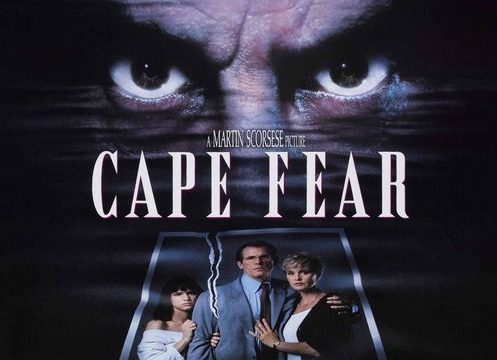Doug’s Cinematic Firsties is a recurring series wherein Douglas Laman (A.K.A. NerdInTheBasement) will review a well-known classic motion picture that he’s never seen before.
Cape Fear already got off on the right foot with me by having an opening credits sequence designed by Saul Bass. True, it’s not as good of a Scorsese/Bass collaboration as that unforgettable opening to Casino. However, Saul Bass is still Saul Bass and that means Cape Fear gets to kick itself off in a visually stylish manner. As soon becomes apparent, employing Bass isn’t the only way Cape Fear pays homage to mid-20th century filmmaking, the era in which the original Cape Fear was released. Many of the editing and camerawork techniques in the 1991 movie Cape Fear seem to have been lifted from at least thirty-year-old features.
These visual flourishes are used to tell the story of lawyer Sam Bowden (Nick Nolte). He’s got a good job and a loving family consisting of wife Leigh Bowden (Jessica Lange) and teenage daughter Danielle (Juliette Lewis). However, everything gets thrown into chaos by the arrival of Max Cady (Robert De Niro), a recently released felon who was a client of Bowden’s. He’s got a bone to pick with Bowden, who he blames for getting him locked up in the slammer for fourteen years. At first, Cady’s vengeance against Bowden is by being more of a nuisance than anything else. He just lingers on the public property right outside of Bowden’s house or “accidentally” runs into Bowden in a parking lot.
But soon, things escalate as Bowden’s dog mysteriously dies and Cady corners Danielle at her school. As Bowden fights back, he’s viewed by the public as the actual enemy while Cady is perceived to be a victim. Will Cady’s nightmare ever end? More importantly, is Cape Fear all that thoughtful of a film? Not really. Scorsese has built his career upon making movies about warped people (Travis Bickle, Jordan Belfort, Frank Sheeran, Robert Pupkin, etc.) to instill deep questions in the viewer. Why do we worship the people we do? Why do we crave power? What is the cost of pursuing status over all other things? These hefty queries ensure that you’re thinking about many of Scorsese’s works long after the credits roll.
In the case of Cape Fear, there isn’t much in the way of either moral complexity or larger questions being posed. Written by Wesley Strick (whose adapting both the earlier Cape Fear film and the 1957 novel The Executioners by John D. MacDonald), Cape Fear is a stripped-to-the-bone thriller. That means Cape Fear isn’t the most substantial work in Scorsese’s filmography. However, Scorsese and his regular collaborators De Niro and editor Thelma Schoonmaker are all still in rare form here, so Cape Fear still registers as a well-made thriller. Strick’s script moves along at a solid pace and conjures up a number of intense set pieces for Scorsese and company to thoughtfully execute.
The best of these is an encounter between Cady and Danielle at her High School. It’s hard to properly express just how uncomfortable this extended sequence is. Cady just makes your skin crawl from the moment he starts talking to Danielle. That sensation only gets worse as his creepy verbiage makes it clear he plans to get more intimate with her. Scorsese’s direction and especially Schoonmaker’s editing make the uncomfortable ambiance of this scene appropriately suffocating. This impressive command of suspense is most prominently seen in this squirm-inducing sequence but it is not the only instance that Cape Fear chills you to the bone.
A nighttime scene involving Joe Don Baker’s investigator character watching over a homemade security system already prepares you for the worst the moment it begins. Nothing gruesome is happening on-screen but the overwhelming quiet and dim lighting combine to put a pit in your stomach. Somewhere, Cady is watching. But where? This character proves to be so unnerving in large part due to De Niro’s performance. As Cady, De Niro instills the character with a sense of totally sincere conviction. He’s not lying to himself about who’re the good guys and bad guys in his life. In his warped mind, Cady truly believes he’s the crusader for justice. De Niro makes a man who believes in himself something terrifying to behold.
Honestly, the vast majority of Cape Fear worked like a charm for me, just a darn good thriller that gave me exactly what I wanted. If I have a complaint, though, it’s that Cape Fear peaks too early in its climax. A cocky Cady lighting up his trademark cigar only to be doused in lighter fluid by Danielle and then bursting into flames is such a perfect conclusion for the character. After that brilliance, the sight of Charlie Parker playing a trumpet while riding a unicorn would be underwhelming.
Unfortunately, Cape Fear does try to follow it up. We get not one but two fake-out deaths for Cady as well as two further showdowns between Cady and the Bowden family. None of the subsequence confrontations are anywhere near interesting enough to make one wonder why they couldn’t end things with the lighter fluid bit. Aside from a clumsier finish, though, Cape Fear has a good sense of what’ll the viewer tick. The good sense to kick things off with a Saul Bass opening makes Cape Fear’s commendable creative sensibilities immediately apparent.

